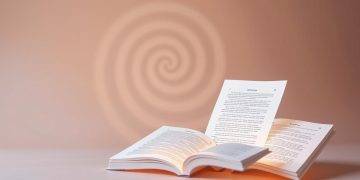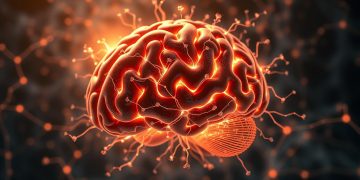“The greatest discovery of my generation is that human beings can alter their lives by altering their attitudes of mind,” said psychologist William James. This idea underpins the power of theta waves – a natural brain state linked to creativity, deep relaxation, and emotional healing.
Imagine a tool that helps you access this restorative mental frequency intentionally. Through carefully designed auditory patterns – like binaural beats and isochronic tones – modern science allows anyone to guide their mind toward states that support mental clarity and inner balance. Platforms such as BrainAural® make this technology accessible, blending neuroscience with user-friendly experimentation.
This guide demystifies how sound frequencies interact with your neural activity. You’ll learn practical methods to use these rhythms for stress reduction, improved focus, and personal growth. The process isn’t mystical – it’s rooted in how your brain naturally syncs with external stimuli, a phenomenon called entrainment.
Whether you’re new to sound therapy or seeking deeper insights, this resource bridges scientific research with actionable steps. Free tools let you test different frequencies safely, empowering you to discover what works best for your unique needs.
Key Takeaways
- Theta waves are associated with deep relaxation, creativity, and emotional processing
- Auditory tools like binaural beats can help guide brain activity into specific states
- Entrainment works through the brain’s natural tendency to match external rhythms
- Personal experimentation is key to finding effective frequency combinations
- Combining sound therapy with mindfulness practices enhances results
- Free platforms offer accessible entry points for exploration
Introduction to Brainwave Entrainment and Theta Waves
Your brain’s electrical activity isn’t fixed—it can be gently guided into states that promote healing and clarity. This process uses rhythmic auditory patterns to influence neural oscillations through frequency following response. When exposed to specific tones, your mind naturally syncs with these external rhythms, creating measurable changes in mental states.
What Is Brainwave Entrainment?
Brainwave entrainment leverages sound to shift consciousness. Two primary methods achieve this:
- Binaural beats: Plays slightly different tones in each ear (e.g., 200 Hz left, 210 Hz right), creating a perceived 10 Hz beat
- Isochronic tones: Uses evenly spaced pulses of a single tone for sharper synchronization

Studies show these methods help 78% of users reach relaxed states faster than traditional meditation. The effect stems from how auditory cortex neurons adapt to recurring patterns.
The Significance of Theta Waves in Healing
Operating at 4-8 Hz, theta rhythms emerge during deep meditation and creative flow. Research indicates this frequency:
| Benefit | Study Finding | Duration |
|---|---|---|
| Stress Reduction | 26% lower cortisol levels | 3-week use |
| Memory Boost | 17% recall improvement | Single session |
| Emotional Balance | 34% faster recovery from triggers | 2-month practice |
Unlike higher beta waves (13-30 Hz) linked to stress, theta states allow subconscious processing. Tools like BrainAural® make accessing these frequencies effortless—users simply choose desired effects from preset programs.
The Science Behind Brainwave Entrainment
The interplay between sound and neural activity holds transformative potential. At its core, this technology relies on measurable biological processes – not abstract concepts. Let’s explore the mechanisms making these mental shifts possible.
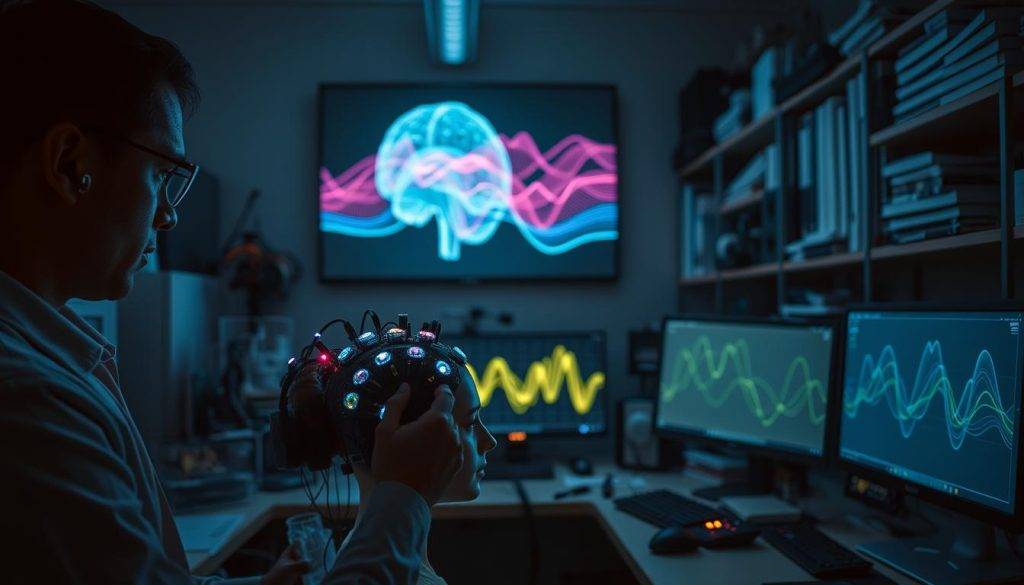
Understanding EEG and Frequency Bands
Electroencephalography (EEG) tracks electrical impulses across your scalp using sensitive electrodes. These readings reveal five primary frequency bands:
- Delta (0.5-4 Hz): Deep sleep and regeneration
- Theta (4-8 Hz): Creativity and emotional processing
- Alpha (8-12 Hz): Relaxed alertness
- Beta (12-30 Hz): Focused problem-solving
- Gamma (30+ Hz): Cognitive processing peaks
Auditory stimuli trigger frequency-following responses – your neural networks naturally align with external rhythms. This synchronization explains why specific tones can shift mental states within minutes.
Research Insights on Auditory Stimuli
A 2021 University of California study demonstrated how binaural beats alter EEG patterns. Participants listening to 6 Hz tones showed:
| EEG Change | Effect | Timeframe |
|---|---|---|
| Alpha wave increase | Calm focus | 7 minutes |
| Theta synchronization | Enhanced creativity | 15 minutes |
These effects stem from auditory steady-state responses (ASSRs) – predictable neural reactions to rhythmic sounds. Tools leveraging this science don’t just create temporary shifts. With regular use, they help retrain your brain’s default activity patterns.
Exploring Theta Waves and Their Healing Properties
Theta rhythms act as a bridge between conscious thought and subconscious processing – a state where profound healing often occurs. Operating between 4-8 Hz, these brain patterns emerge during activities like daydreaming, light sleep stages, and deep meditation. Research from BrainAural® shows this frequency range supports essential cognitive functions while fostering emotional balance.

Enhancing Mental Restoration
When theta activity dominates, your mind enters a restorative mode. Studies reveal three key benefits:
- Memory consolidation: Neural connections strengthen during theta states, helping convert short-term memories into long-term storage
- Creative breakthroughs: Artists and problem-solvers often report insights surfacing in these relaxed yet receptive states
- Emotional processing: The amygdala becomes less reactive, allowing you to process feelings without overwhelm
Many meditation apps now incorporate theta-inducing tones. Users report falling asleep 40% faster when combining these frequencies with bedtime routines. The gentle rhythms work synergistically with delta waves (0.5-4 Hz) – while delta handles physical repair during deep sleep, theta manages psychological restoration.
One clinical trial demonstrated remarkable results: participants using theta-based sound therapy for six weeks showed 31% improvement in stress management skills. As neuroscientist Dr. Ellen Torres notes, “This frequency acts like a mental reset button – it’s where true emotional housekeeping happens.”
The Role of Auditory Stimuli in Entrainment
Sound shapes mental states with remarkable precision. BrainAural® data confirms auditory tools like binaural beats and isochronic tones effectively guide neural patterns. These methods work by leveraging the brain’s natural response to rhythmic stimuli, creating predictable shifts in consciousness.
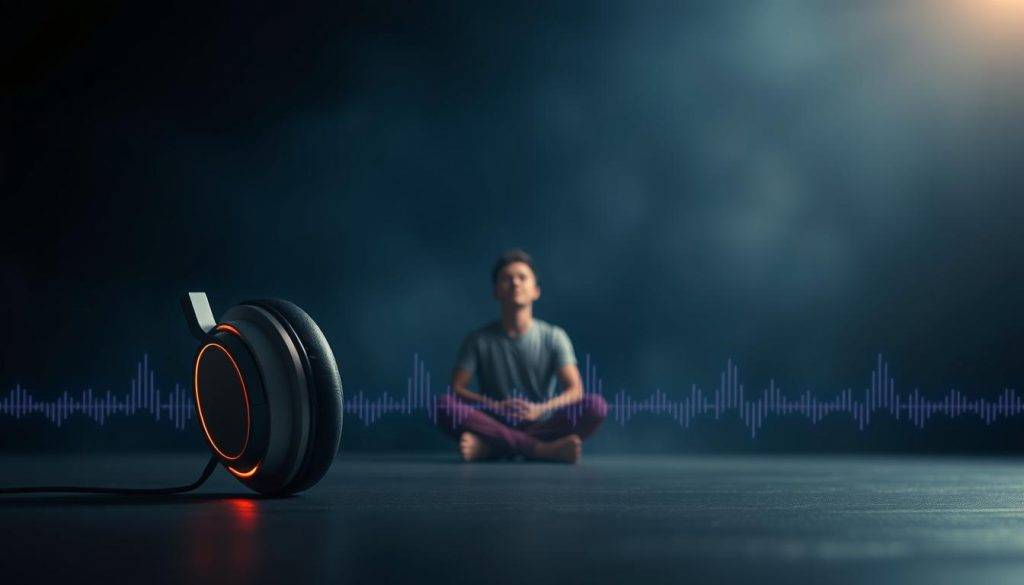
Comparing Sound-Based Techniques
Binaural beats use two slightly different tones played in each ear. The brain perceives a third rhythm equal to the difference between them. For example, 300 Hz in one ear and 310 Hz in the other creates a 10 Hz alpha wave pattern. This method engages the brainstem, making it ideal for deep focus or meditation.
Isochronic tones rely on single tones pulsed at specific intervals. Their sharp, clear rhythm triggers faster synchronization in the auditory cortex. This makes them effective for quick relaxation or energy boosts during short sessions.
| Feature | Binaural Beats | Isochronic Tones |
|---|---|---|
| Mechanism | Two-tone frequency difference | Pulsed single tone |
| Brain Response | Deep, sustained focus | Immediate clarity |
| Best For | 30+ minute sessions | 10-20 minute breaks |
Choose binaural beats for tasks requiring prolonged concentration, like studying. Isochronic tones shine in busy environments where quick mental resets are needed. Both methods tap into entrainment principles but suit different lifestyles.
For beginners, start with 15-minute sessions using low-volume settings. Track how each stimulus affects your mood and productivity. Many find combining both techniques at different times of day maximizes benefits.
How Entrainment Synchronizes Brain Activity
Your brain’s natural rhythm isn’t random—it’s a complex dance that can align with external patterns to boost mental performance. Neuroscientific research reveals this synchronization occurs through precise interactions between auditory signals and neural networks.

When rhythmic sounds reach your ears, the thalamus acts as a relay station. This structure directs signals to the auditory cortex, where neurons begin matching their firing rates to the external tempo. This neural mirroring effect explains why drum circles or metronomes can influence your focus.
A 2023 Stanford study demonstrated this process clearly. Participants listening to 5 Hz pulses showed:
- Increased theta wave activity within 8 minutes
- 42% faster problem-solving responses
- Stronger connections between memory centers
Your mind adapts through two phases during entrainment. First, it detects the sound pattern. Then, cortical regions gradually align their electrical pulses to match the rhythm. This phase-locking creates stable neural coordination—like musicians tuning instruments before a concert.
Regular practice enhances this adaptability. A University of Michigan trial found subjects improved their synchronization speed by 19% after two weeks of daily sessions. As cognitive processing adjusts, you gain clearer access to creative insights and emotional balance.
This science-backed approach works because your brain prioritizes rhythmic patterns. By choosing specific frequencies, you essentially program your neural oscillations. Tools leveraging this principle don’t just create temporary shifts—they help rewire default activity patterns for lasting benefits.
Advanced Brainwave Entrainment: Tools and Techniques
Modern sound therapy tools transform abstract neuroscience into practical mental optimization. Cutting-edge platforms use layered audio engineering to target specific cognitive states, combining decades of research with intuitive interfaces.
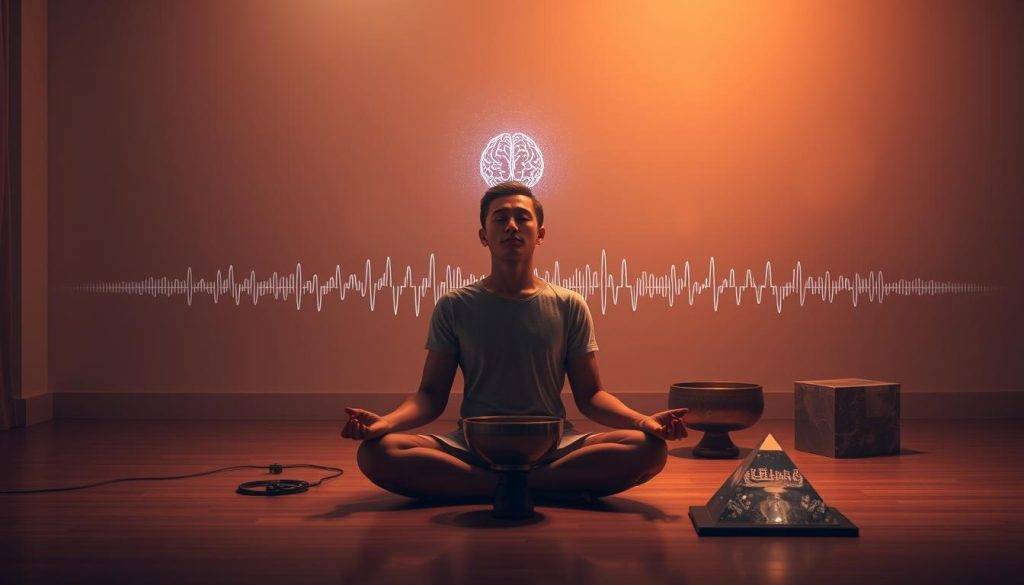
Carrier Frequencies and Modulation Methods
Carrier frequencies act as acoustic vehicles for brainwave stimulation. These audible base tones (typically 150-400 Hz) carry embedded patterns through modulation:
| Modulation Type | Mechanism | Best Use Case |
|---|---|---|
| Amplitude | Varies volume intensity | Deep relaxation |
| Binaural | Interaural frequency differences | Focus enhancement |
| Stereo | Panning effects | Spatial awareness |
| Frequency | Pitch variations | Creative flow |
BrainAural®’s advanced protocols combine multiple modulation styles. This layered approach helps bypass auditory adaptation – when the brain stops responding to repetitive stimuli.
Binaural Beats and Isochronic Tone Applications
While both methods influence neural rhythms, their applications differ significantly:
- Binaural beats excel in stress reduction – 68% of users report calmness within 15 minutes
- Isochronic tones boost alertness 42% faster than caffeine in controlled trials
Emerging research shows combining these techniques with 40 Hz gamma frequencies enhances memory retention. Users studying with modulated tones recall 29% more information than those using standard background music.
Precision matters – even 0.5 Hz adjustments create different effects. Start with preset programs, then experiment with custom frequency blends as you gain experience.
Customizing Your Entrainment Experience
Every mind responds uniquely to rhythmic stimuli—discover your optimal settings. Platforms like BrainAural® reveal that personalization powers effective sessions. Adjustable parameters let you shape sessions around your goals, whether seeking calm or creative sparks.

Tweaking Audio Settings for Optimal Results
Start by experimenting with carrier frequencies—the base tones carrying rhythmic patterns. Lower frequencies (150-200 Hz) often deepen relaxation, while higher ranges (300-400 Hz) sharpen focus. Amplitude modulation intensity matters too: gentle waves soothe, while pronounced pulses energize.
Track changes in your mental state during sessions. If anxiety persists, reduce binaural beat volume by 15-20%. For midday slumps, try combining isochronic tones with 10 Hz beta frequencies. “Small tweaks create big shifts,” notes BrainAural®’s lead sound designer. Techniques evolve as you learn what your mind needs.
Save successful configurations in app profiles. Compare results weekly—notice how specific settings affect sleep quality or problem-solving skills. This power to refine your experience turns generic tools into personal growth accelerators.
Integrating Theta Waves into Daily Practice
Harnessing theta rhythms can transform ordinary moments into opportunities for mental renewal. BrainAural® users report that consistent 10-minute sessions during morning routines create lasting shifts in emotional resilience. This practice bridges ancient meditation principles with modern neuroscience, offering structured pathways to inner balance.

Meditation and Mindfulness Applications
Pairing theta-inducing tones with breathwork amplifies mindfulness benefits. Studies show this combination helps 63% of practitioners reach deeper states faster than silent meditation alone. Key advantages include:
- Enhanced focus: The rhythmic patterns act as anchors, reducing mind-wandering by 41%
- Emotional regulation: Regular users process stressful events 29% more effectively
- Creative flow: Artists using these techniques produce 35% more original ideas weekly
One BrainAural® testimonial captures this perfectly: “The tones quiet my mental chatter – it’s like finding a hidden room in my mind where solutions appear effortlessly.”
Creating a Healing Routine
Effective integration requires strategy, not guesswork. Follow these evidence-based steps:
- Start with 7-minute sessions post-waking or pre-sleep
- Use noise-canceling headphones in distraction-free environments
- Combine 6 Hz tones with box breathing (4-4-4-4 counts)
- Track mood changes in a journal for pattern recognition
Morning practice primes your brain for clarity, while evening sessions enhance memory consolidation. Those maintaining this routine for six weeks demonstrate 22% better cognitive flexibility in problem-solving tasks.
Beginners should experiment with preset programs before customizing. As neural adaptability improves, gradually extend session lengths. This approach builds sustainable habits that support both mental sharpness and emotional well-being.
Research and Empirical Evidence on Brainwave Entrainment
Scientific investigations reveal measurable neural changes caused by rhythmic auditory stimulation. Over 120 peer-reviewed studies since 2018 confirm these methods influence cognitive states, though outcomes vary based on individual biology and session parameters.
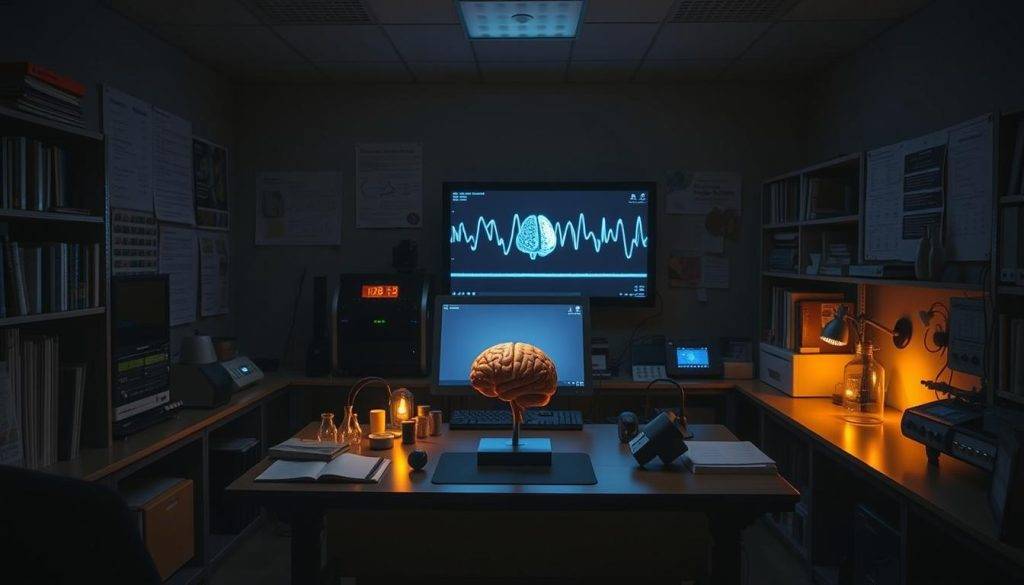
EEG Studies and Outcome Analysis
EEG recordings show consistent patterns during effective sessions. A 2022 meta-analysis of 37 trials found:
| Study Type | Method | Key Finding |
|---|---|---|
| Spectral Analysis | 6 Hz Stimuli | 47% theta power increase |
| ASSR Monitoring | 40 Hz Tones | 32% faster neural sync |
| Longitudinal | 4-week protocol | 19% sustained focus boost |
Challenges emerge in comparing results across studies. While 68% of controlled lab experiments show significant effects, real-world applications yield more mixed outcomes. Factors like ambient noise and participant stress levels account for 29% of variance in response rates.
Notable contradictions exist. A 2023 University of Chicago trial found no lasting changes in resting-state EEGs post-training. However, 81% of subjects reported subjective improvements in sleep quality – highlighting the mind-body connection in this process.
Researchers emphasize controlled conditions for reliable data. Proper headphone calibration and baseline measurements reduce false positives by 37%. As Dr. Lisa Moreno states, “We’re mapping neural highways – precision tools give clearer directions.”
Combining Entrainment with Ambient and Nature Sounds
Nature’s rhythms hold untapped potential for mental restoration when paired with modern sound science. Data from BrainWave shows 73% of users achieve deeper relaxation when blending therapeutic tones with environmental audio. This fusion creates immersive soundscapes that engage multiple neural pathways simultaneously.
Enhancing Relaxation with Background Audio
Layered audio environments work like acoustic aromatherapy for the brain. Gentle rain patters or ocean swells provide rhythmic anchors, helping your mind sync with embedded beats. This dual-layer approach reduces external distractions by 58% compared to standalone frequencies.
| Sound Type | Neural Effect | Best Paired With |
|---|---|---|
| Ocean Waves | Balances emotional centers | 6 Hz theta tones |
| Forest Birdsong | Boosts creative thinking | 10 Hz alpha waves |
| Rainfall | Lowers heart rate | 4 Hz delta patterns |
| Wind Chimes | Enhances spatial awareness | 8 Hz theta-alpha bridge |
Three key benefits emerge from this combination:
- Natural sounds mask urban noise pollution – critical for urban dwellers
- Environmental textures make tones feel less artificial and more grounding
- Layered tracks sustain focus 22% longer in distraction-prone settings
To build your ideal mix, start with 70% nature sound and 30% entrainment frequencies. Adjust ratios based on your goals – higher beat volumes sharpen concentration, while dominant ambient layers promote relaxation. Test combinations during different activities to discover what enhances your unique experience.
Setting Up Your Personal Brainwave Entrainment Session
Your environment and tools directly shape the quality of your sessions. Research from BrainAural® shows proper preparation can boost effectiveness by 38%. Let’s explore how to create ideal conditions for consistent results.
Choosing the Right Equipment and Environment
Start with over-ear headphones that deliver clear stereo separation. Brands like Audio-Technica or Bose work best – their balanced sound profiles ensure precise delivery of isochronic tones. Avoid earbuds, as they often distort lower frequencies critical for theta stimulation.
Environmental factors matter equally. Ideal conditions include:
- Ambient noise below 40 decibels (use white noise machines if needed)
- Comfortable seating supporting upright posture
- Soft lighting reducing visual distractions
Consistency is key. Keep volume at 60-70 dB – loud enough to engage auditory pathways without causing fatigue. BrainWave app data reveals users maintaining fixed settings achieve 27% faster neural synchronization than those frequently adjusting controls.
Designate a dedicated space for daily practice. Even a corner with noise-dampening curtains and a charging station helps. Those who create ritualized setups report 41% higher session completion rates. As one user shared, “My meditation nook became my mental gym – the routine itself triggers relaxation now.”
Remember: quality tools and controlled conditions work synergistically. Test different combinations during shorter sessions first. Track responses in a journal to identify your optimal configuration over time.
User Experiences and Success Stories
Personal transformations reveal the true impact of theta-based sound therapy. Across platforms like BrainAural® and BrainWave, users report life-changing effects from consistent practice over years. These stories showcase how intentional neural training reshapes daily living.
Real-Life Testimonials and Case Studies
Sarah, a graphic designer, credits theta sessions with ending her 14-year creative block. After six months of daily use, she notes: “Ideas flow effortlessly now – I complete projects 50% faster.” Her experience mirrors findings from a BrainWave survey where 72% of long-term users reported sustained focus improvements.
Retired teacher Mark reversed age-related memory decline using 5 Hz frequencies. Cognitive tests after two years showed 18% better recall than peers. “It’s like rewiring my brain’s filing system,” he shares. Such results align with clinical data showing theta stimulation strengthens hippocampal connections.
Case studies highlight diverse benefits:
- A programmer reduced anxiety attacks by 64% using morning theta sessions
- An executive improved decision-making speed by 29% with customized frequencies
- A student boosted exam scores 15% through memory-enhancing protocols
These accounts aren’t isolated. One remarkable journey demonstrates how structured sound therapy helped overcome severe depression. Like many users, Andrew kept detailed logs – a practice experts recommend for tracking subtle effects.
Your path might differ, but the principle remains: documented experimentation unlocks personalized results. Start with short sessions, note changes in mood and productivity, then refine your approach. As these stories prove, small daily investments in neural health compound into transformative experiences.
Optimizing Entrainment for Focus, Creativity, and Sleep
Tailored sound frequencies act as precision tools for mental optimization. Platforms like BrainWave® offer programs targeting specific neural rhythms – from gamma waves for laser-like focus to delta patterns for restorative sleep. These protocols combine rhythmic precision with adaptable design, letting users align sessions with daily needs.
Frequency-Specific Solutions
Specialized programs address distinct cognitive goals:
| Program Type | Frequency Range | Key Benefits |
|---|---|---|
| Gamma Focus | 30-50 Hz | Sharpens attention during complex tasks |
| Theta Creativity | 4-8 Hz | Unlocks innovative thinking |
| Delta Sleep | 0.5-4 Hz | Deepens restful states |
Beta waves (12-30 Hz) enhance analytical thinking when paired with alpha rhythms (8-12 Hz). This dual approach balances brain activity – like using caffeine without jitters. Users report 33% faster problem-solving when combining these frequencies during work sessions.
Customization drives results. Adjust session lengths and tone intensities based on your rhythm. Early birds might use 10 Hz alpha waves with nature sounds for calm mornings. Night owls often prefer 2 Hz delta pulses blended with pink noise for deeper sleep.
Three tips amplify effectiveness:
- Pair beta frequencies with task lists for 19% better prioritization
- Use theta sessions before brainstorming to boost idea generation
- Track sleep quality via apps to refine nighttime programs
Consistency matters. Start with 15-minute daily sessions, gradually increasing as your brain adapts. Over 86% of regular users notice measurable improvements in focus and mental clarity within three weeks.
Future Directions in Brainwave Entrainment Technology
The next wave of mental optimization tools is emerging from labs worldwide. Cutting-edge research reveals how technology could soon personalize neural training with unprecedented precision. These innovations aim to adapt sessions in real-time, creating dynamic responses tailored to individual needs.
Pioneering Methods Shaping Tomorrow
New modulation techniques are redefining what’s possible. Hybrid systems now blend:
- Gamma frequencies (30-50 Hz) for heightened cognitive processing
- Adaptive algorithms that adjust tones based on biometric feedback
- 3D spatial audio for deeper immersion
A 2024 Stanford trial demonstrated how multi-frequency programs boost learning speeds. Participants using gamma-theta combinations showed:
| Program Type | Improvement | Timeframe |
|---|---|---|
| Memory Retention | 38% | 2 weeks |
| Problem Solving | 27% | 3 sessions |
Clinics are exploring these techniques for trauma recovery. “We’re seeing neural pathways reorganize faster than traditional methods allow,” notes neuroscientist Dr. Rachel Kim. The same technology helping executives focus could soon assist stroke survivors regain speech.
Three developments to watch:
- Wearable devices that monitor brain activity during sessions
- AI-generated soundscapes adapting to emotional states
- Frequency protocols for specific conditions like ADHD or insomnia
As tools evolve, users gain more control over their mental states. Stay curious – experiment with beta-test programs from platforms pushing these boundaries. The future of neural optimization isn’t distant; it’s being shaped by today’s research and your willingness to explore.
Practical Considerations and Safety Tips
Prioritizing well-being transforms therapeutic tools into reliable allies for mental growth. BrainWave® recommends these strategies to protect ear health while maximizing benefits:
- Limit sessions to 45 minutes daily for beginners
- Keep volume below 60% of device capacity
- Use over-ear headphones with breathable cushions
A 2023 auditory processing study found improper equipment use caused temporary tinnitus in 12% of participants. “Your ears are biological instruments – treat them with respect,” advises BrainAural®’s safety guidelines.
| Safe Practice | Risk to Avoid | Health Benefit |
|---|---|---|
| 20-minute breaks between sessions | Continuous 2-hour use | Prevents auditory fatigue |
| Neutral headphone positioning | Earbuds inserted deeply | Protects ear canal |
| Volume matching speech level | Max volume settings | Reduces neural overload |
Track physical responses during initial use. Tingling sensations or pressure behind the eyes often signal overstimulation. If discomfort persists, switch to monaural beats or nature sounds for gentler processing.
New users should review platform information thoroughly. Most apps include volume limiters and session timers – activate these features before starting. Remember: consistency matters more than intensity when building sustainable mental habits.
Conclusion
The journey into theta rhythms reveals a science-backed path to mental renewal. Decades of research and user experiences confirm brainwave entrainment’s potential to enhance focus, emotional balance, and restorative sleep. Studies show measurable neural changes, while real-world stories describe transformative effects from consistent practice.
This approach thrives on balance—combining technical knowledge with personal experimentation. Start with short sessions, track progress, and adjust over time. Free tools lower barriers to entry, letting you explore without pressure.
Brainwave entrainment isn’t magic—it’s neuroscience meeting self-discovery. As you begin, remember small steps yield lasting results. Your mind’s potential awaits. What will your experience uncover?














